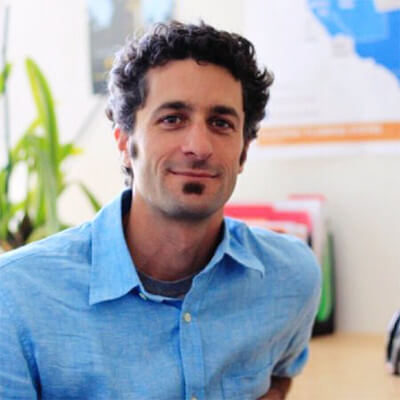Direct messaging: Joe DiStefano
Resiliency planner, startup founder, SimCity aficionado
July 12, 2022
What’s the problem you want to solve?
Public and private institutions around the globe are struggling to prioritize where to invest in the face of unprecedented climate threats and social challenges.
From agencies that manage public assistance programs, energy utilities looking to strengthen their grids against accelerating heat waves and fire risks, to financial institutions hedging against climate risk and economic stress, organizations of all kinds are seeking answers to all of their “where” questions.
Specifically for the public sector, deepening social inequities and the profound, disparate impacts of the COVID-19 crisis have laid bare the inadequacy of current systems to provide decision-makers with the clear and honest information they need to drive effective and equitable decisions.
Agencies that manage food, rental and housing-fund assistance are constantly challenged with locating eligible and vulnerable households in their outreach efforts, monitoring program enrollment progress, and ultimately ensuring that benefits get to those in need. These aid systems are deeply fragmented, made up of a diverse set of agencies at the federal, state and local levels and community organizations and programs that are largely siloed.
This results in a critical information gap on the scope and impact of our government’s response to the needs of the most vulnerable Americans.
How do we solve it?
Now more than ever, organizations require a complete view into the intersection between communities, climate and the build environment.
By compiling this previously siloed data into one comprehensive view, they can derive actionable insights for decision-makers to respond to the world’s changing social and environmental conditions.
How do you define community resiliency?
Community resilience is the capacity of communities and the stakeholders rebuilding, financing and insuring the world’s physical and social infrastructure to prevent, withstand, and quickly recover from major disruptions and plan for the future.
This has become urgent as the abnormal and extreme has become increasingly common.
What role does UrbanFootprint play in this?
UrbanFootprint’s mission is to build resilience in our infrastructure, communities and citizens, and we do this through our cloud-native urban intelligence platform that provides the powerful data insights needed for analysts, planners, designers and policymakers to deploy resources intelligently.
UrbanFootprint consolidates, maps and analyzes thousands of previously-siloed data points covering climate, land use and economic and social conditions to surface actionable insights within a proprietary canvas of 160 million land parcels that cover nearly every inch of the United States.
With sector-specific data products and mapping tools, organizations can hone in on any area in the country and quickly evaluate existing conditions across hundreds of community, social, and environmental metrics, measure and map risk and market opportunities, and prioritize where to deploy interventions and investments. As a result, we are helping some of the country’s largest and most influential institutions target where to invest resources to reduce climate and social vulnerability and increase the resilience of critical infrastructure and communities.
For example, this year, we launched our Government Assistance Program Intelligence solution, which augments existing agency systems with ready-to-use insights on program need, eligibility, and enrollment.
Unlike traditional approaches to analyzing program performance and outreach, Assistance Program Intelligence takes a holistic approach, combining risk and eligibility mapping with a program’s enrollment and operational data and other population factors. Overlaying these broadly-sourced and disparate datasets allows stakeholders to immediately improve outreach targeting, especially among disadvantaged and priority populations, and enable holistic program improvements—all through a simple and intuitive browser-based interface.
How are communities using UrbanFootprint?
Currently, Assistance Program Intelligence is being used by major state and local governments to target billions of dollars in food, housing, and disaster relief to vulnerable Americans. In California, the Local Initiatives Support Coalition, a non-profit community development institution designated by the state to implement its Emergency Rental Assistance Program, is leveraging UrbanFootprint to target application assistance for California’s $5 billion in rental assistance funding.
And in Louisiana, the Department of Children and Family Services, which oversees the state’s Supplemental Nutrition Assistance Program and other benefit programs, is using UrbanFootprint to support front-line teams and local partners in mapping and measuring need; then closing the gap between SNAP eligibility and enrollment, reducing food insecurity across the state. In part due to its work in this area, UrbanFootprint has been approved by the USDA as a SNAP outreach provider and is currently the first—and only—recognized USDA technology partner.
Along with public agencies, we work with customers across the energy, finance, enterprise, and real estate sectors. For example, energy utilities use our energy solutions to prioritize where to deploy new EV chargers and where to invest in infrastructure upgrades with precise, fast, accessible insights on the resilience of U.S. service territories and communities. Additionally, major financial institutions and insurers deploy our ESG and finance solutions to understand where climate threats and economic stress will impact investment risk and returns.
What does our world look like if we leverage data in the way you are?
Organizations equipped with the best data and latest tools make better decisions for their communities.
By empowering stakeholders with valuable and action-oriented insights, we can ensure that tomorrow’s energy grid can withstand the effects of climate change, insure against climate vulnerabilities, and address service and equity gaps in government assistance programs around the country.
